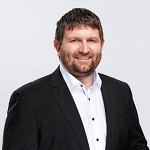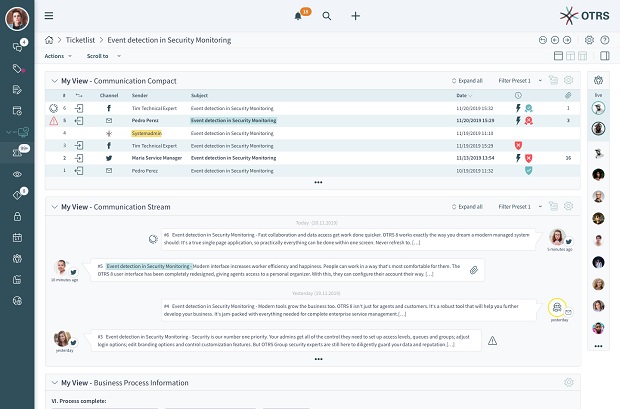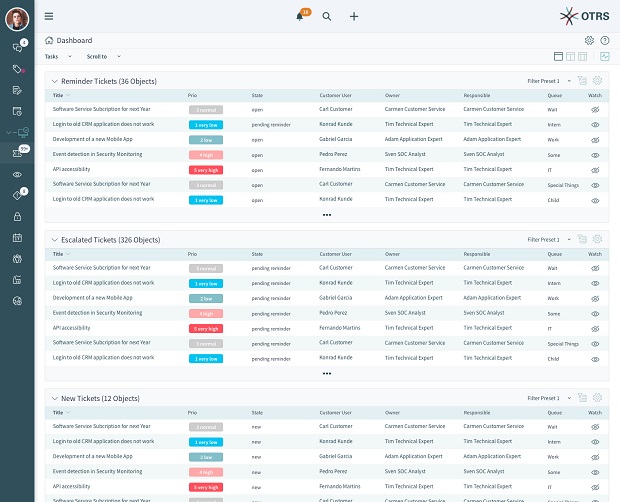A new release of the OTRS service management solution will be on the market soon. A major release like OTRS 8 means that development teams work at full speed for a year or more to design, build and test the product. We talked to Manuel Hecht, Vice President Global Software Development at OTRS Group, about the development process and what it takes for a team to bring a new product of this scale to market.

Q: Let’s start at the beginning. What is it you and your team have been working on over the past year or more?
A: There are two main developments compared to our prior version, OTRS 7, to mention. First, the new agent interface; second, the ability of OTRS 8 to directly connect to Facebook, Twitter and LinkedIn.
Q: What drove you to these innovations? Was it feedback from customers?
A: Yes, in both cases it was the customer feedback as well as our own conviction. The new agent interface of OTRS 8 is much more than just a new look. We have rethought the entire way the user interacts with OTRS, so we have not only modernized the technology under the hood, but we have completely replaced it.
When it comes to connecting to Facebook, Twitter and LinkedIn, it was simply clear to us that companies are no longer communicating only by phone and email, but are also using a whole range of communication channels. OTRS 8 takes this into account and opens up further communication channels. And it’s important to note that OTRS 8 continues to preserve the revision history and all other advantages of OTRS even for these new channels; we treat them with the same philosophy as the existing channels.
Q: In your words, what does it mean to modernize software?
A: OTRS 8 is by far the biggest modernization release in OTRS history. With OTRS 8, we have replaced more code than ever before. This, of course, is no guarantee for success or quality, but it is a prerequisite for real innovation. Only if you are willing to cut off old habits will you have the freedom for profound innovation; when you do so, you don’t have to deal with old problems.
This is especially true for the new agent interface of OTRS 8. We deliberately decided not only to renew the look & feel of the interface, but also to completely rewrite the whole technical foundation. This radical step allowed us to build the code architecture in such a way that the interface could be developed about five times faster than with the previous interface technology. In other words, if we hadn’t taken this radical step, we would never have been able to complete OTRS 8 in such a short time.
 Recommended: Chicago Steak Company – A Premier Provider Of Gourmet Dry Aged Beef, USDA Prime Steaks, Seafood And Desserts
Recommended: Chicago Steak Company – A Premier Provider Of Gourmet Dry Aged Beef, USDA Prime Steaks, Seafood And Desserts
Q: It has required a lot of teamwork to complete OTRS 8. This is despite the fact that most of the developers are working from home, i.e. in many different locations. How did you manage to motivate the team every day?
A: You are motivated when you see a logic in what you are doing. Besides the advantages of the new interface for our users, there are also important aspects for us developers, especially when it comes to the technology under the hood. The previous interface technology has accompanied us from 2001, the birth of OTRS, until today — for almost 20 years. That alone shows how good OTRS has been, because 20 years is quite old by information technology standards. Nevertheless, it was no longer current and, above all, couldn’t adapt to future requirements.
For us developers, it was essential to create an architecture that could be changed and developed much faster than the previous one. It was also important for us to find ways to make OTRS 8 with all its available additional modules quickly maintainable and updatable. For the future success of OTRS, not only is a nice look important, but also the ability to quickly adopt new developments in IT and adapt to new requirements is critical. We have taken all this into account and implemented it in the development of OTRS 8. We now have completely different technical possibilities than before.
In addition to these very technical motivations, we attach great importance to collegial and fair cooperation among all. The developers always work on a problem in small groups, coordinate daily and exchange experiences. Top-down management only exists where it is absolutely necessary. The teams essentially organize themselves. On the one hand, this requires a high level of discipline; on the other hand, it increases their own personal freedom despite the high pressure to perform. In this way, high motivation can be achieved even over a longer period of time with a high workload.
Q: What were the biggest challenges during the development work for you?
A: The biggest challenge for us was, first of all, the sheer size of the project. As I mentioned before, OTRS 8 has seen more code swapped between releases than ever before. Today, I can say that my team has done it. But at the beginning of the project, this was anything but certain. There were reasonable doubts about if it was even possible to implement so many changes at once in such a short time. We had to reorganize ourselves completely – create new internal structures and responsibilities that had not existed before. In addition, we had to divide the big overall project into small sub-projects in order to make it feasible and manageable for us. Plus, we had to solve a number of technical problems in the course of development. To list them all would go far beyond the scope here. Just to say this much: I am so incredibily proud of my team! So much passion and dedication, but also technical expertise and openness to new things, is something very special.
Q: You have now completed an absolute development marathon to present OTRS 8 quickly. How do you feel? What will you do next?
A: I am a bit exhausted, I have to admit. But first and foremost, I am satisfied and proud of what we have achieved. I have talked a lot about my development team and myself, but I would like to emphasize that OTRS 8 is not only a feat of the OTRS developers, but also an extraordinary achievement of all OTRS Group employees. To successfully develop such a complex product and then make it available to our customers requires much more than “just” development. It requires detailed market analysis in advance, obtaining and evaluating customer feedback, extensive marketing activities and of course stable financial planning for the entire duration of the project. It is also essential to prepare our service delivery teams for OTRS 8 and enable them to provide excellent service to our customers. But the work on OTRS does not end with the release of OTRS 8; there is still a lot to do and many more goals to achieve.
Q: I suspect that there is not too much time to relax, because after the launch is before the launch, as we all know. When do the preparations for OTRS 9 start?
A: Actually, the preparations for OTRS 9 have already started. Our list of ideas and customer requests is long and will continue for many OTRS versions, far beyond OTRS 9. Besides the preparations for OTRS 9, it is also important to implement some changes in our internal procedures and processes. The performance of a team or the whole company has to grow with the requirements. One component for this is to constantly question and improve our working methods and also the tools used.
Q: Can you tell us something about OTRS 9?
A: At the moment, I would like to keep a low profile on OTRS 9. I can only say this much — we will not stop improving OTRS. With OTRS 8, we have laid the foundation for further innovative solutions. We will continue to listen to the needs of the market and give our customers what they need to be successful.
Activate Social Media:


 Recommended:
Recommended: 